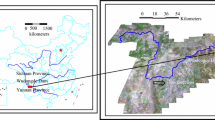Abstract
With the real-time recording of the health care system, real-time monitoring of user trajectory data can effectively protect the health and health of the body. In order to accurately establish the spatial position trajectory data prediction model, a space trajectory data prediction model based on variable space chaotic particle swarm optimization (CPSO)-optimized least squares support vector machine (LSSVM) is proposed. Firstly, aiming at the problem that particle swarm optimization (PSO) is easy to fall into local optimum, the global optimization performance of PSO algorithm is improved by using variable space chaos search strategy and particle out-of-bounds mirror processing strategy. Numerical simulation experiments verify the superiority of improved particle swarm optimization algorithm. Based on the CPSO algorithm, the hyper parameters of the CPSO-optimized least squares support vector machine (CPSO-LSSVM) are proposed to improve the prediction accuracy of the model. Finally, using GeoLife and T-Drive dataset as the research object, the CPSO-LSSVM spatial position prediction model is established by using the trajectory data of the dataset. The simulation experiment verifies that the CPSO-LSSVM positional space prediction model has higher prediction accuracy and more strong generalization ability to accurately and effectively predict spatial location.








Similar content being viewed by others
References
Chen H, Xu J, Jianglong GX (2018) Fast auto-clean CNN model for online prediction of food materials. J Parallel Distrib Comput 117:218–227
Wu B, Yan X, Wang Y, Guedes Soares C (2017) An evidential reasoning-based CREAM to human reliability analysis in maritime accident process. Risk Anal 37(10):1936–1957
Chen H, Xie X (2016) An efficient recommendation filter model on smart home big data analytics for enhanced living environments. Sensors. 16(10):1–26
Wu B, Zong L, Yan X, Guedes Soares C (2018) Incorporating evidential reasoning and TOPSIS into group decision-making under uncertainty for handling ship without command. Ocean Eng 164:590–603
Chen H, Ouyang Y, Jiang W (2015) An optimized data integration model based on reverse cleaning for heterogeneous multi-media data. J Multimed Tools Appl:1–16
Wang Y, Zio E, Wei X, Zhang D, Wu B (2019) A resilience perspective on water transport systems: the case of eastern star. Int J Disaster Risk Reduct 33:343–354
Lee K, Lee J, Kwan MP (2017) Location-based service using ontology-based semantic queries: a study with a focus on indoor activities in a university context [J]. Comput Environ Urban Syst 62:41–52
Widhalm P, Nitsche P, Brandie N (2012) Transport mode detection with realistic smartphone sensor data. International conference on pattern recognition. IEEE, pp 573–576
Shih DH, Shih MH, Yen DC, et al (2015) Personal mobility pattern mining and anomaly detection in the GPS era[J]. Cartography and Geographic Information Science 43(1):1–13
Gunduz S, Yavanoglu U, Sagiroglu S (2014) Predicting next location of twitter users for surveillance [C]// International conference on machine learning & applications. IEEE, pp 267–273
Bogomolov A, Lepri B, Staiano J, et al (2014) Once upon a crime: towards crime prediction from demographics and mobile data [C]// Proceedings of the 16th international conference on multimodal interaction (ICMI).ACM, New York, pp 427–434
Qiao S, Han N, Zhu W et al (2015) TraPlan: an effective three-inone trajectory-prediction model in transportation networks [J]. IEEE Trans Intell Transp Syst 16(3):1188–1198
Jiang W, Carter DR, Fu H, Jacobson MG, Zipp KY, Jin J, Yang L (2019) The impact of the biomass crop assistance program on the United States forest products market: an application of the global forest products model. Forests 10:215
Rezaee Jordehi A (2015) Enhanced leader PSO (ELPSO): a new PSO variant for solving global optimisation problems [J]. Appl Soft Comput 26(1):401–417
Huang L, Ding S, Yu S, Wang J, Lu K (2016) Chaos-enhanced cuckoo search optimization algorithms for global optimization [J]. Appl Math Model 40(5–6):3860–3875
Zhang Y, Zhao Y, Fu X et al (2016) A feature extraction method of the particle swarm optimization algorithm based on adaptive inertia weight and chaos optimization for Brillouin scattering spectra [J]. Opt Commun 376(10):56–66
Fei W, Zhou L, Hui R et al (2017) Search improvement process-chaotic optimization-particle swarm optimization-elite retention strategy and improved combined cooling-heating-power strategy based two-time scale multi-objective optimization model for stand-alone microgrid operation [J]. Energies 10(12):1936
Bansal JC, Farswan P (2017) Wind farm layout using biogeography based optimization [J]. Renew Energy 107:386–402
Zheng Y, Xie X, Ma W (2010) GeoLife: a collaborative social networking service among user, location and trajectory [J]. IEEE Data Eng Bull 33(2):32–40
Liu C, Niu P (2017) A hybrid heat rate forecasting model using optimized LSSVM based on improved GSA [J]. Neural Process Lett 45(1):299–318
Funding
This work was supported by the Science and Technology Research Program of Chongqing Municipal Education Commission (KJQN201802101, KJZD-K201802101).
Author information
Authors and Affiliations
Corresponding author
Additional information
Publisher’s note
Springer Nature remains neutral with regard to jurisdictional claims in published maps and institutional affiliations.
Rights and permissions
About this article
Cite this article
Chen, G., Li, Z. Improved particle swarm optimization LSSVM spatial location trajectory data prediction model in health care monitoring system. Pers Ubiquit Comput 26, 795–805 (2022). https://doi.org/10.1007/s00779-019-01291-4
Received:
Accepted:
Published:
Issue Date:
DOI: https://doi.org/10.1007/s00779-019-01291-4




